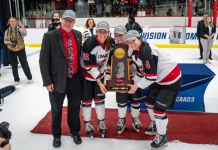Welcome to U.S. College Hockey Online’s roundtable discussion. Each week, various members of our staff take on a hockey topic. Sometimes serious, sometimes silly — but either way, watch the feathers fly: no punches will be pulled, and no quarter given, when these people face off.
Of the Four Major Conferences, Which is the Strongest This Season?
Tim Brule, USCHO Coordinator: Two conferences are up — the CCHA and the ECAC — and the other two down. The ECAC has struggled for national respect for the last few years, but last year each ECAC team went down fighting in the NCAA tournament. This year Vermont has jumped out to a sizzling start with wins over New Hampshire, Boston University, Miami and Lake Superior. This is the only team in the nation with three legitimate Hobey Baker candidates in Eric Perrin, Martin St. Louis and Tim Thomas. Clarkson returns a strong team lead by Todd White, and Colgate is a real sleeper. In the early season their power play has been on fire.
The CCHA is headed by Michigan and Michigan State. Michigan returns the whole enchilada: nine seniors led by Brendan Morrison and the Short-Handed Scoring Machine, John Madden. The big question with Michigan is the possibility of a letdown after last year’s unbelievable playoff run. As for the Spartans, this is not the year, but they will scare the &*?#$ out of several CCHA teams on the way to another NCAA tournament berth. The Spartans are young; their big guns are mostly underclassmen — Sean Berens, Mike Watt, Mike York. At this point in the season I am not sure where to put Bowling Green or Miami.
Top to bottom, the CCHA seems to have it all this year. With Illinois-Chicago gone the little guys are thinning out. Notre Dame is much improved, as Bowling Green learned the hard way. Last year the regular-season championship went down to the last weekend, and we’re in for more of the same this year. I would not be surprised to see two CCHA teams in Milwaukee.
The real question is, who wants to face the Cats first?
Mike Machnik, Special Projects: An age-old question rears its ugly head once again. I’ve seen too much college hockey over the years to think that anyone can easily come up with an answer to end this controversy once and for all. There are a myriad of criteria that can be used to justify ranking any of the conferences at the top, or at the bottom for that matter. Nonconference record, poll rankings, NCAA titles, NCAA appearances and so on, have all been used in the past by folks looking to advance the cause of their own conference. Usually it is more telling to examine the “facts” that they choose to ignore rather than the ones they trumpet as incontrovertible evidence.
As they say in the NFL, “On any given day….” A simple look at the results to date shows that this axiom is not limited to football. Rensselaer beat Northeastern, which beat Michigan State, which beat Michigan.
Just remember: there are lies, damn lies, and statistics, and statistics are the worst of the bunch. You can use them to make any case you want. With that in mind, my admittedly wishy-washy answer would be: none of them…and all of them.
Scott Brown, Assistant Editor: First off, let’s ask ourselves what this question really means. Rating a team is pretty simple, if inexact; you look at records, schedule strength, and so on. For an entire conference, though, it’s a little bit harder. The NCAA finds this out every year when it tries to pick tournament teams in basketball by ranking conferences.
But I’m willing to give it a shot anyway. The proper question is this: if every team in my conference played every team in your conference, who’d win more games? Now there’s a question we can answer — and the CCHA comes out on top.
The rap on the CCHA for years has gone something like this: sure, they’ve got a strong upper echelon — Michigan, Michigan State, Bowling Green, Lake State and maybe Western Michigan — but the rest of the league is pretty soft. Ohio State? Notre Dame? Football schools that wouldn’t know a slapshot from a drop pass. For Pete’s sake, it got so bad at Illinois-Chicago that the program disintegrated. A conference like that can’t be very good, can it?
Well, folks, look again. The Buckeyes and the Irish aren’t jokes any more, and Miami is in the top ten nationally — and perfect in the conference. Anybody, top to bottom, can beat anybody these days in the CCHA. Just look at Alaska-Fairbanks, which took out national power Michigan State in East Lansing last weekend, not two weeks after the Spartans dumped NCAA champion Michigan. This is the sign of a competitive conference — a strong league from top to bottom. The CCHA gets my vote.
Jayson Moy, ECAC Correspondent: There are two ways to answer this question, and they give different results.
Method one is top to bottom. Where is the strength for all the teams in the conference? That would be the WCHA. Colorado College is a perennial power these days, and you can’t forget about Minnesota. I thought Denver was not as strong, but they swept ECAC power Clarkson. Then there are surprises in Duluth, St. Cloud and North Dakota. That gives six strong teams in the conference. Let’s add Wisconsin, and don’t forget about Michigan Tech.
Method Two is a look at the best teams at the top. This one is a closer call. While the WCHA features several good teams, the strongest ones in the nation seem to come from the CCHA and the ECAC.
In the CCHA, you have the defending champions in Michigan, picked by many to repeat this season. Michigan State has shown fortitude early, and there is also Bowling Green. And Miami has been a huge surprise this season. Here we have four of the top teams in the nation.
In the ECAC, Vermont is now number three in the nation. Clarkson and Colgate are also among the nation’s best, with explosive offense and great golatending. Cornell, too, might be among the elite.
So if you take method one, you get the WCHA. Method two gives the CCHA or the ECAC.


